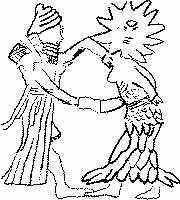Nancy Sherer
Unearths the Prehistoric Athena
|
Athena, representing natural forces, is an ageless icon. Gray-eyed Athena is best known as the Greek goddess of Athens. Although Greek mythologies list her as a goddess, the Greeks did not view their gods as anthropomorphic entities. Words like god and goddess are virtually meaningless when talking about how the Athenians felt about Athena. Athena was not a supernatural entity. She was regarded much like Americans consider the Statue of Liberty at Ellis Island a symbol of freedom and safe harbor. Athena represented the Greek ideal of wisdom and statesmanship. Athena was protector of Athens as an abstraction of Athenian patriotics. Most governments consider themselves worshippers of wisdom. Most governments claim that god is on their side in matters of war. Athena’s ancient connection to wisdom and war made her obvious choice for Athens’s political figurehead. Although she was foreign to Greece, she was welcomed as the daughter of the sky and sea, Zeus/Poseidon. (That Zeus and Poseidon were the same god is universally accepted by mythographers.) Two separate origin myths have Athena springing from the forehead of Zeus or from Lake Triton. References to her gray eyes as well as reference to her monster-fish totem, Erichthonius, echoes her close association with the waters. In historic times, some have tried, unsuccessfully, to identify her with the death aspect of the Triple Goddess of the Moon. Athena remains unreconciled to the White Goddess who was defined and popularized by Robert Graves. All she has in common with Artemis is that they were both ancient forces to be reckoned with. Athena was never connected with the moon, but rather she is so closely connected to the sun that it is necessary to be skeptical of her definition as female. Athenians found Athena walking the islands of Attica as the sister/companion of the solar hero, Perseus, but she is more ancient and well-traveled than that. Early evidence of her is from archeological digs in North Africa. Called Neith, Anatha, Libya, or Sphinx are the same entity expressed in different languages. In the oppressive summer heat when the grass crackles beneath your feet, it would be accurate to say, “Neith is ravaging the earth.” She was the destructive heat that killed plants and spread plague through settlements. A more accurate title for Neith would be Titan. The Greek historian, Herodotus identified this force of nature as Athena. Like Prometheus, Atlas, and Cronus, Neith’s power was more general than just the summer heat. Through all her evolutions from Libya to Egypt to Athens, Neith’s domain was both sky and water. Her totems of snake and lion are emblems of her ancient titanic powers of wisdom and strength.
The Oriental concept of duality is clear in Neith’s aspect as destroyer/protector. Her icons are identified as the Libyan Snake, but she is portrayed as lion-headed. She remains recognizable as both male and female, water and sky. Like yin-yang, the prehistoric Athena/Medusa deals out death and protection, plague and healing. She knows the light and reason from the sun, and she knows the mysteries of the River Styx. Snakes and the Sphinx remain her attributes into historical times. By the dynastic period in Egypt, Neith had a new incarnation as Sekmet. She retained the sun-disk and lion head, but she gained more godlike aspects. Here she became the power of the sun that protected Egypt from enemies. Her image is found opposite Isis at graves. As protector of the dead, the Titan Neith became the goddess Sekhmet. Through her travels, she gained attributes such as the horse, the owl, and the goat-skin shield called an Aegis. Throughout all her permutations, throughout the ages, her identity remained inseparable from the male sky god Zeus/Poseidon. They were the same entity. Athena emerged fully grown from the forehead of the sky. The sky-symbol, Pegasus, sprung from the neck of Athena’s alter-ego, Medusa. It was from this hermaphroditic duality that the sexless, modern concept of Athena descended. She still wears her sister/self icon on her aegis. Athena and Medusa were not two goddesses, but rather a single force of nature that changes through the course of time. They were the Gray Sisters who shared the single Eye in the Sky and the Tooth of Wisdom between them. Athena the Sphinx, born from the forehead of the Sky each morning descended into the waters of Ocean for her nightly journey through the underworld. She became monstrous Medusa, who turned men to stone, and had to be destroyed by the solar hero, Perseus. From Medusa’s neck sprung the new sun, and the golden armed hero who would slay the monster of the following day. Athena put the bridle on the solar Pegasus, and a new day began. Athena, the daughter of the sea and sky, holds the key to the Riddle of the Ages because she was there at the beginning of the cycle of time. |
|
Back
to Nancy's Index or you may choose to go Back to SalmonRiver Home Page
|
Copyright 1997 - 2004
SalmonRiverPublishing
All rights reserved
